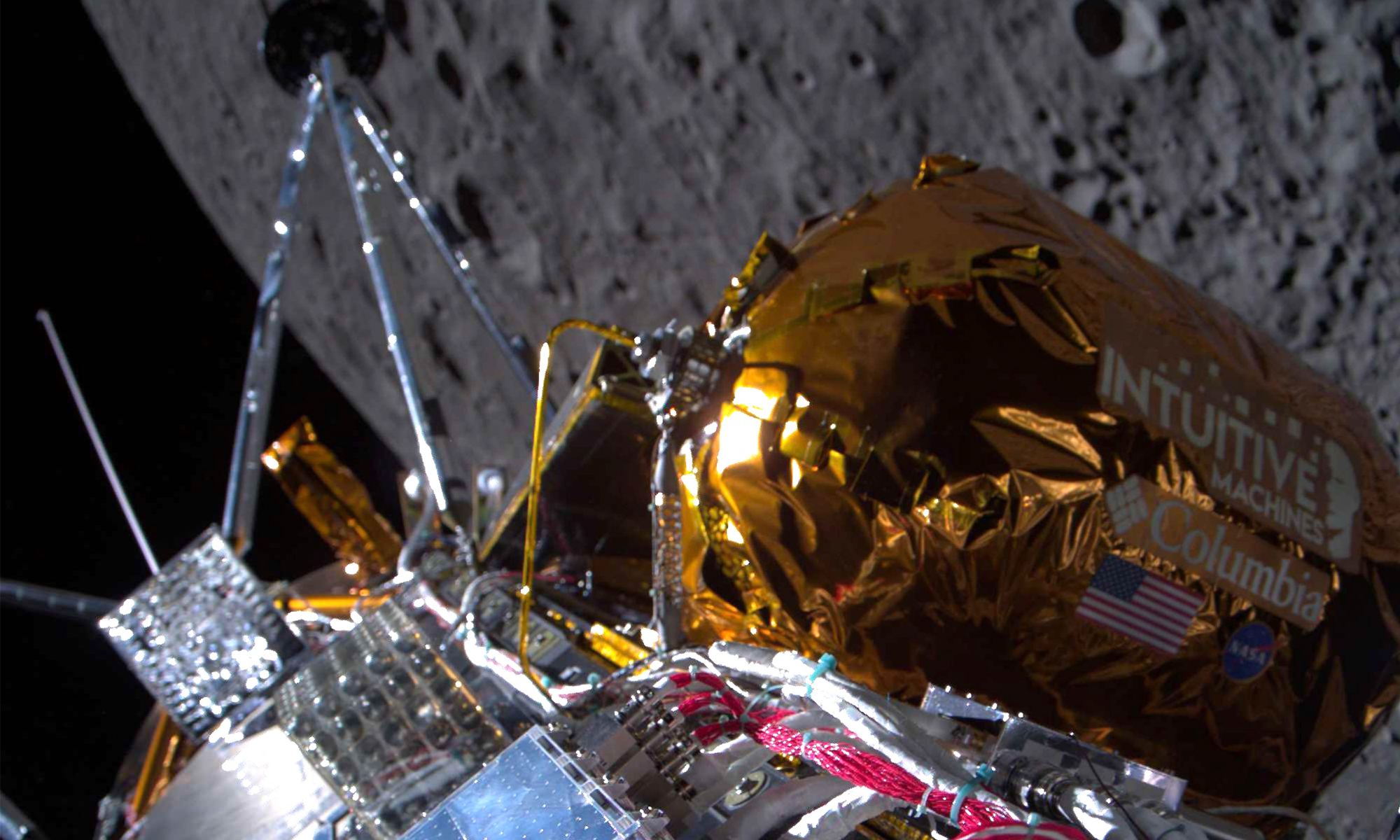Intuitive Machines‘ Odysseus lander made space history today — becoming the first commercial spacecraft to survive a descent to the moon, and the first U.S.-built spacecraft to do so since the Apollo 17 mission in 1972. But it wasn’t a trouble-free landing.
Ground controllers had a hard time establishing contact with the robotic lander just after the scheduled touchdown time of 6:23 p.m. ET (2323 UTC). Several minutes passed, and then Intuitive Machines mission director Tim Crain reported that there was a faint signal coming from Odysseus’ high-gain antenna.
“We’re not dead yet,” he said.
A few minutes later, the IM-1 mission team decided that the signal was evidence enough that Odysseus was still operating.
“What we can confirm without a doubt is our equipment is on the surface of the moon, and we are transmitting,” Crain said. “So, congratulations, IM team, we’ll see how much more we can get from that.”
As mission team members applauded, Intuitive Machines CEO Steve Altemus radioed in with his congratulations. “I know this was a nail-biter, but we are on the surface and we are transmitting,” he said. “Welcome to the moon.”
“Houston, Odysseus has found his new home,” Crain replied.
What Odysseus was designed to do
Odysseus, which is named after a seafaring hero in Greek mythology, was launched from NASA’s Kennedy Space Center on Feb. 15. The mission’s objective was to deliver payloads from NASA and commercial customers to a spot near Malapert A crater in the lunar south polar region. That area of the moon is of high interest because its cratered terrain is thought to hold resources of water ice that could be eventually be used to supply crewed outposts.
NASA is paying Houston-based Intuitive Machines $118 million for the delivery under the terms of its Commercial Lunar Payload Services initiative.
The space agency’s payloads include a camera system that was designed to document the plumes of dust kicked up by the landing, an experimental radio navigation beacon, a radio-based fuel gauge, a laser range finder, a set of laser reflectors and a sensor that will study the moon’s electron plasma environment. Data from the experiments could help NASA plan for the Artemis program’s crewed lunar landings, which could start happening as soon as 2026.
The commercial payloads range from a box of 125 marble-sized moon sculptures and a digital data storage device to a mini-observatory that could capture pictures of the lunar surface and the Milky Way above. There’s also a camera system that was designed to be dropped off during the descent to take “selfie” pictures of the touchdown.
Backup systems come into play
Odysseus reached lunar orbit on Feb. 21, and went through a series of maneuvers today to descend from an altitude of 92 kilometers (57 miles).
NASA’s laser range finder, known as the Navigation Doppler Lidar or NDL, ended up playing a crucial backup role in guiding the descent. Just a couple of hours before landing, Intuitive Machines reported that controllers couldn’t get Odysseus’ own laser range finders to work — so they reprogrammed the lander to use NASA’s NDL system instead.
In the wake of the landing, Intuitive Machines’ mission control team went through a series of procedures aimed at resetting equipment and boosting the signal from Odysseus.
“After troubleshooting communications, flight controllers have confirmed Odysseus is upright and starting to send data,” Intuitive Machines reported in a posting to X / Twitter. “Right now, we are working to downlink the first images from the lunar surface.”
There’s a chance that Odysseus went off track during the final stages of the descent and ended up landing askew. That’s what happened a month ago when Japan’s SLIM spacecraft tumbled into an awkward position on its lunar landing site. SLIM’s off-kilter solar arrays were able to soak up enough power for an abbreviated round of science observations.
Even under the best of circumstances, the solar-powered Odysseus lander is expected to be in operation on the lunar surface for only seven days. The mission is slated to end when the sun drops below the lunar horizon and the circuit-chilling lunar night begins.
Past and future lunar robots
NASA’s deputy associate administrator for exploration, Joel Kearns, noted in advance of the landing that the odds for a completely successful commercial moon landing were slim.
“This is not an easy thing we’ve asked these companies to do, but if they’re successful, the up side for American exploration is just so great we have to try it,” Kearns said.
Last month, Pittsburgh-based Astrobotic missed out on sending its Peregrine lander to the lunar surface, due to a propellant leak that was detected after launch. The past year has also seen moon landing failures by Russia and a Japanese private venture, as well as successes by the Japan Aerospace Exploration Agency’s SLIM team and India’s space agency.
Still more commercial moon landing attempts are on NASA’s calendar: Intuitive Machines is already working on another lander that will drill for ice in the moon’s south polar region. Meanwhile, Astrobotic is getting set to send NASA’s VIPER rover to a spot near the south pole, and Firefly Aerospace is due to deliver 10 NASA payloads to Mare Crisium aboard its Blue Ghost lander.
NASA Administrator Bill Nelson accentuated the positive in a pre-recorded video message that was released on the assumption that Odysseus survived its descent to the surface.
“Today, for the first time in more than half a century, the U.S. has returned to the moon,” Nelson said. “Today, for the first time in the history of humanity, a commercial company, an American company, launched and led the voyage up there. Today is a day that shows the power and promise of NASA’s commercial partnerships. … This feat is a giant leap forward for all of humanity. Stay tuned.”
Stay tuned, indeed.

